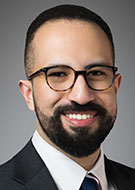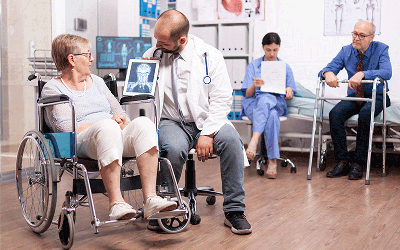From Translation Apps to Mobile Imaging Units, Radiology Programs Can Fight Health Disparities With Realistic Strategies
Social determinants of health can include social, economic and environmental challenges

To address the challenges marginalized communities face in accessing quality imaging services, radiologists need a game plan that is feasible in a real-world setting. An article in Radiology outlines practical strategies for promoting equitable imaging access for all patients.
"It’s crucial to not only understand the interplay of social determinants of health and imaging access but also to actively develop, adopt and implement tailored and sustainable strategies to improve current disparities,” said Mohab M. Elmohr, MD, an interventional radiology resident at Baylor College of Medicine in Houston. “This can involve advocating for health policies, innovating solutions and engaging with the community.”
The Role of Economic Stability
Economic stability is a critical component of social determinants of health (SDOH), Dr. Elmohr’s team pointed out, citing its impact on timely access to imaging resources, particularly in cancer and stroke.
Women working in the service industry who are eligible for mammogram screening, for example, are less likely than those in other fields to have had a mammogram in the past year. Meanwhile, a study on stroke care in the Scandinavian Journal of Trauma, Resuscitation and Emergency Medicine found that, when adjusting for age, sex and confirmed stroke diagnosis, patients with low socioeconomic status experienced an additional delay of at least 30 minutes between the time emergency services were contacted and the time they received a radiologic exam.
Economic stability encompasses an array of factors, including employment, income, debt, medical bills, food insecurity and insurance coverage, Dr. Elmohr said. Radiologists can practice cost-effective imaging by using evidence-based guidance and best practices to help ensure that patients are getting the appropriate services.
“There is often a trade-off between the cost of imaging and its diagnostic quality,” the authors noted. “To optimize this trade-off, imaging decision-making should be based on careful consideration of both costs and quality.”
They recommend incorporating financial counseling to help patients navigate insurance coverage, copay assistance, and other financial aid to help reduce the cost burden for patients in marginalized communities.
“Dedicated departmental resources to subsidize imaging for patients experiencing financial hardships can also be a helpful measure in reducing disparities,” Dr. Elmohr said.

Advocacy and Cultural Awareness are Important Tools for Radiologists
And a radiologist’s impact can extend beyond clinical practice into legislative decisions. Local, state and federal lawmakers respond to letters from physicians with stories of their experiences with day-to-day practice. These letters can be powerful tools to advocate for policy change that benefits both patients and health care.
“Reaching out to policymakers can be a powerful method to advocate for meaningful changes,” Dr. Elmohr said. “These communications can be among the few credible sources of real-world insights and expert opinions necessary to inform their decisions, yet the role of advocacy is often underestimated. It should be regarded as an integral part of patient care and public health engagement.”
Another SDOH challenge is patients’ access to education. Dr. Elmohr’s team outlined research that directly correlates patients’ education levels to timely diagnosis and effective treatment of both breast cancer and stroke.
“Assessing patients’ health literacy and providing accommodations to barriers can greatly improve patient outcomes,” Dr. Elmohr said. “Providing cultural competency training to all radiology staff is also a good practice and many validated resources are readily accessible online, often at no cost.”
For patients who speak a language different from the imaging team members, the authors suggest using resources like RadTranslate™, which can provide standardized, multilingual audio instructions for common exams and procedures.

Don’t Overlook Physical and Emotional Accessibility
The neighborhood where a patient resides can have a profound effect on health outcomes, and the design and accessibility of imaging centers can be major factors.
Imaging facilities should be in convenient, accessible locations easily reached by public transportation or by foot and designed with accessibility in mind, the authors recommend.
“Radiologists can work with local organizations and government agencies to influence these factors to invest in a city’s environment by creating health-promoting infrastructure,” Dr. Elmohr said, “
Social isolation also influences disparities, particularly in cancer and stroke care. Confronting this intricate problem might involve joining forces with skilled resource workers and radiology staff can partner with community-based organizations to help better understand the needs of marginalized patients.
Dr. Elmohr and his fellow authors suggest participating in community-based research to integrate academic researchers and community members.
“The active participation of community members in the research process cultivates robust academic-community alliances, augments comprehension of community contexts and circumvents exploitative research practices,” they said.
And, importantly, radiology teams should remember the immense value of employing a diverse staff. Patients respond more favorably, and have more favorable health outcomes, when the medical teams who serve them represent their own communities.
Finally, the authors addressed access to quality health care, outlining the success of mobile van units as a sustainable option in areas where traditional imaging access is limited.
"Mobile imaging units can significantly enhance access to diagnostic services, especially in underserved areas,” Dr. Elmohr said. “In the greater Houston area, MD Anderson’s mobile mammography van program brings critical screenings provided by experienced technologists and radiologists directly to underserved communities, improving early detection rates as well as removing geographical and financial barriers."
Dr. Elmohr noted that this article only provides a glimpse into the deep and complex barriers to health care access that some communities face.
“In our paper, we strived to cover the topic objectively and to paint a more vivid picture of the situations that overwhelmingly impact individuals and families and that have taxing consequences on the health care system,” he said. “The intricate nature of the issue at hand might mean we haven't captured every nuance in full granularity. We hope to have stimulated thoughtful conversation on this critical subject.”
For More Information
Access the Radiology study, “Social Determinants of Health Framework to Identify and Reduce Barriers to Imaging in Marginalized Communities.”
Access the Scandinavian Journal of Trauma, Resuscitation and Emergency Medicine study.
Read previous RSNA News stories on health equity:
- Changes Needed to Make Health Care Screenings Equitable
- Working Toward Equitable, Accurate and Impactful Radiology Research
- Opportunities Abound for Health Care Institutions to Impact Systemic Health Equity
RadTranslate™ Offers Imaging Room Assistance
Designed to help radiology techs and nurses direct patients during exams and procedures, RadTranslate offers eight categories of AI-powered audio clips in various languages.
Clicking on a particular procedure provides instructions for imaging positioning, breath holds and removal of clothes and jewelry for the procedure. Each clip also includes introductory language, such as asking for the patient’s name and birthdate. Each clip is translated into Spanish, Portuguese, Mandarin, Italian, Arabic, Korean and Romanian.
RadTranslate is a diversityxMESH product, a collaboration between the MESH Incubator™ at Massachusetts General Hospital (MGH) and the MGH Department of Radiology Diversity, Equity, & Inclusion committee. DiversityxMESH’s aim is to develop practical solutions to reduce health disparities and provide more equitable care to patients.